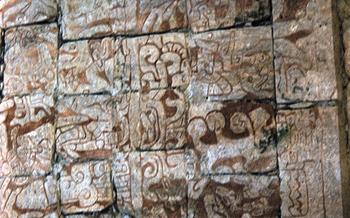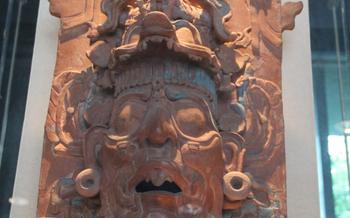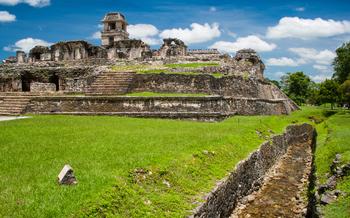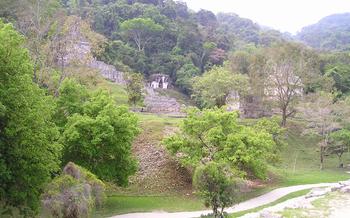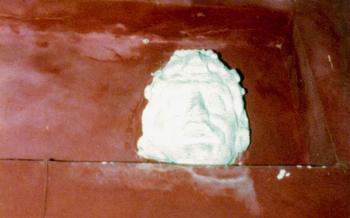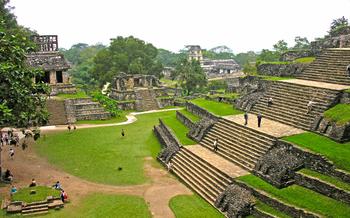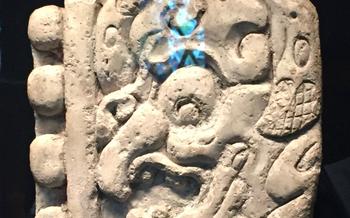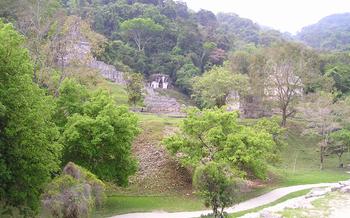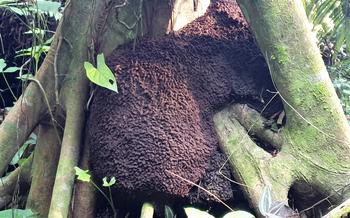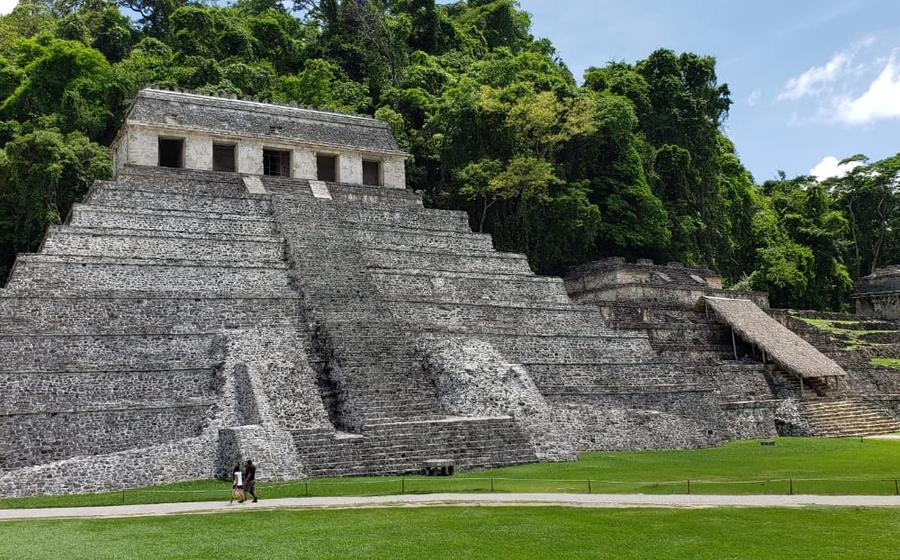
Templo XIII
- History: Unveiling the Past
- Architecture: A Masterpiece of Design
- Exploration: Discovering the Temple's Secrets
- Rituals and Ceremonies: A Glimpse into Mayan Spirituality
- Restoration and Conservation Efforts: Preserving the Legacy
- Cultural Significance: A Symbol of Mayan Heritage
- Mayan Art and Symbolism: Deciphering the Messages
- Guided Tours: Enriching the Experience
- Local Cuisine: A Taste of Palenque
- Accommodations: Rest and Relaxation in Palenque
- Safety and Precautions: Ensuring a Smooth Visit
- Souvenirs and Shopping: Taking Home a Piece of Palenque
- Insider Tip: Unforgettable Sunrise Views
History: Unveiling the Past
In the depths of the Mayan jungle, Templo XIII stands as a testament to the ingenuity and devotion of the ancient Maya civilization. Its origins are shrouded in mystery, believed to have been constructed around the 7th century AD during the Late Classic period. The temple's construction is a testament to the Mayans' advanced architectural techniques, with its precise alignment and intricate carvings.
The purpose of Templo XIII remains a subject of debate among scholars and historians. Some believe it served as a sacred place of worship, where the Maya performed rituals and ceremonies to honor their gods. Others suggest it may have functioned as a celestial observatory, as its alignment with the sun and stars aligns perfectly with key astronomical events.
Beyond its religious and astronomical significance, Templo XIII held deep cultural and spiritual meaning for the Maya. It was believed to be a portal to the underworld, a place where the spirits of the deceased journeyed after death. This belief is reflected in the temple's intricate carvings depicting scenes of death and resurrection.
Architecture: A Masterpiece of Design
Templo XIII stands out for its unique architectural style, a testament to the ingenuity and artistry of the ancient Maya. The temple's most distinctive feature is its stepped pyramid design, which rises majestically from the surrounding jungle. The pyramid is composed of several terraces, each adorned with intricate carvings and sculptures that depict mythological scenes, deities, and historical events.
One of the most striking elements of Templo XIII is its elaborate facade, which is adorned with a series of intricate stucco reliefs. These reliefs depict scenes from Mayan mythology, including the creation of the world and the adventures of the hero twins, Hunahpu and Xbalanque. The facade also features a series of masks and glyphs, which provide valuable insights into Mayan cosmology and religious beliefs.
The interior of Templo XIII is equally impressive, with a series of interconnected chambers and passageways that lead to the temple's inner sanctum. The walls of these chambers are decorated with more stucco reliefs, as well as paintings and murals that depict scenes from Mayan life and rituals.
Overall, Templo XIII is a masterpiece of Mayan architecture, showcasing the incredible skill and artistry of this ancient civilization. Its unique design, intricate carvings, and symbolic iconography make it one of the most impressive and well-preserved structures in the Maya region.
Exploration: Discovering the Temple's Secrets
In the heart of the ancient city of Palenque, Templo XIII stands as a testament to the ingenuity and artistry of the Mayan civilization. As you approach the temple, its towering presence commands attention, inviting you to step back in time and unravel its mysteries.
Begin your exploration by marveling at the intricate carvings and sculptures that adorn the temple's facade. Each glyph, each figure, tells a story, revealing glimpses into the lives and beliefs of the ancient Maya. As you enter the temple, the cool, damp air envelops you, transporting you to a different era.
Follow the narrow corridors and climb the steep staircases, feeling the weight of history beneath your feet. Each step brings you closer to the temple's inner sanctum, where you can imagine the rituals and ceremonies that once took place within these sacred walls.
Take your time to explore the temple's various chambers, each with its unique features and significance. Admire the well-preserved murals and paintings that depict scenes from Mayan mythology and history. Imagine the vibrant colors that once adorned these walls, bringing the stories to life.
As you wander through the temple, you may encounter other visitors, but the sheer size and grandeur of the structure ensure that you can find moments of solitude and contemplation. Take advantage of these quiet moments to connect with the spirit of the ancient Maya and let their legacy wash over you.
Remember to bring your camera to capture the temple's beauty from every angle. The play of light and shadow on the stone surfaces creates stunning photographic opportunities, especially during the golden hours of sunrise and sunset.
Rituals and Ceremonies: A Glimpse into Mayan Spirituality
Templo XIII held immense religious significance in Mayan culture, serving as a sacred site for various rituals and ceremonies. The Mayans believed that the temple was a portal to the underworld, where they could communicate with their ancestors and deities. Important ceremonies, such as the K'inich Ahau, a festival honoring the sun god, took place within the temple's hallowed halls. During these ceremonies, Mayan priests performed intricate rituals, offering sacrifices and prayers to ensure the well-being of their people and the prosperity of their land. The temple's alignment with the Mayan calendar and cosmology further emphasized its crucial role in their spiritual beliefs. Templo XIII stands as a testament to the deep connection the Mayans shared with their gods and the cosmos.
Restoration and Conservation Efforts: Preserving the Legacy
Templo XIII has undergone extensive restoration and conservation efforts over the years, aimed at preserving its historical significance and architectural integrity. In the early 20th century, archaeologists began documenting and excavating the site, unearthing valuable artifacts and uncovering hidden structures. Subsequent restoration projects focused on stabilizing the temple's foundations, repairing damaged walls, and reconstructing missing elements, using traditional techniques and materials to maintain the temple's authenticity.
One of the main challenges faced by conservators is the impact of environmental factors, such as humidity, temperature fluctuations, and vegetation growth. These elements can cause deterioration of the temple's stonework and contribute to the loss of intricate carvings and inscriptions. To address these issues, conservators have implemented measures such as controlled drainage systems, vegetation management, and the application of protective coatings to shield the temple from the elements.
The ongoing conservation efforts at Templo XIII are crucial for ensuring that this ancient masterpiece remains accessible to future generations. By preserving the temple's structural integrity, protecting its unique features, and raising awareness of its historical importance, conservators are playing a vital role in safeguarding a priceless legacy for the world to appreciate.
Cultural Significance: A Symbol of Mayan Heritage
In the tapestry of Mayan culture, Templo XIII stands as a radiant thread, intricately woven with the fabric of identity and heritage. This sacred site is deeply revered by the Mayan people, embodying their rich history, traditions, and spiritual beliefs. It serves as a tangible link to their ancestral past, bridging the gap between generations and fostering a profound sense of connection.
Templo XIII is not merely a structure of stone and mortar; it is a living testament to the indomitable spirit of the Mayan civilization. Its towering presence evokes a sense of awe and wonder, inspiring reverence and respect among all who behold it. Through its intricate artwork, symbolism, and architectural prowess, the temple narrates stories of a once-thriving civilization, showcasing their advanced knowledge of astronomy, mathematics, and engineering.
In modern-day Mexico, Templo XIII remains a beacon of cultural pride and identity for the Mayan people. It stands as a symbol of resilience, perseverance, and the enduring legacy of their ancestors. The temple's significance extends beyond its physical form, reaching into the hearts and minds of the Mayan community, where it continues to inspire, uplift, and unite.
Preservation and promotion of Mayan heritage are essential in ensuring that future generations can continue to draw strength and inspiration from this magnificent site. Through ongoing conservation efforts, educational initiatives, and cultural events, the legacy of Templo XIII and the Mayan civilization lives on, enriching the cultural tapestry of Mexico and the world.
Mayan Art and Symbolism: Deciphering the Messages
Templo XIII is adorned with intricate artwork and symbolism that provide a window into the complex belief system of the ancient Maya. The carvings, sculptures, and motifs found throughout the temple offer valuable insights into their cosmology, mythology, and daily life.
The most prominent symbol depicted in Templo XIII is the sacred tree, which represents the connection between the underworld, the earthly realm, and the heavens. Other common motifs include water symbols, which represent fertility and abundance; jaguar motifs, which symbolize power and strength; and astronomical symbols, which indicate the Maya's advanced understanding of celestial movements.
By carefully studying and interpreting these symbols, archaeologists and historians have been able to piece together a deeper understanding of Mayan culture and their worldview. The artwork on Templo XIII serves as a testament to the artistic prowess and rich imagination of this ancient civilization.
Guided Tours: Enriching the Experience
While exploring Templo XIII independently is rewarding, joining a guided tour offers a deeper understanding and appreciation of the site. Knowledgeable guides bring the history and significance of the temple to life, providing insights into the Mayan civilization and its cultural practices. They can explain the symbolism and iconography found throughout the temple, helping you decipher the messages embedded in the artwork and architecture. Guided tours often include additional information about the surrounding area, pointing out other important landmarks and providing context for the role of Templo XIII within the broader Mayan civilization. Booking a guided tour is highly recommended to enhance your visit and gain a comprehensive understanding of this captivating historical site.
Local Cuisine: A Taste of Palenque
When visiting Palenque, embarking on a culinary journey is a must. The town offers a diverse range of dining options, from traditional Mayan dishes to international cuisine. To truly immerse yourself in the local culture, try "pejelagarto asado," a grilled fish dish that is a specialty of the region. For a taste of Mayan cuisine, indulge in "pochuc," a traditional soup made with corn, beans, and squash. Vegetarians will delight in the variety of fresh fruits and vegetables available, including the local favorite, "plátanos fritos," or fried plantains. Don't miss the opportunity to visit the bustling food markets, where you can sample exotic fruits, freshly squeezed juices, and local delicacies. For a unique dining experience, head to one of the many family-run restaurants in town, where you can savor authentic home-cooked meals and interact with the friendly locals.
Accommodations: Rest and Relaxation in Palenque
When planning a trip to Palenque, choosing the right accommodation is essential for a comfortable and enjoyable stay. The town offers a range of options to suit different budgets and preferences, from budget-friendly hostels to luxurious hotels.
For backpackers and budget travelers, numerous hostels provide dormitory-style accommodations with shared bathrooms. These hostels often have communal areas where guests can socialize and meet fellow travelers. For a more private experience, private rooms with en-suite bathrooms are also available at some hostels.
Mid-range hotels offer a good balance of comfort and affordability. These hotels typically have private rooms with air conditioning, hot water, and basic amenities. Some mid-range hotels also have swimming pools, restaurants, and other facilities.
For those seeking a luxurious stay, several high-end hotels in Palenque offer upscale accommodations with all the amenities one would expect, including spacious rooms, private balconies, and room service. Some of these hotels also have spas, fitness centers, and fine-dining restaurants.
When choosing a place to stay, it's essential to consider the location. Accommodations near the town center are convenient for exploring Palenque's shops, restaurants, and attractions. However, staying further away from the center can offer a quieter and more peaceful experience.
It's always advisable to book accommodations in advance, especially during peak tourist season. This can be done online through booking platforms or directly with the hotel or hostel. Be sure to read reviews and compare prices to find the best deals.
Safety and Precautions: Ensuring a Smooth Visit
Palenque is generally a safe destination, but like any other tourist spot, it's essential to exercise caution and take necessary precautions. When visiting Templo XIII, be mindful of the uneven terrain and slippery steps. Wear comfortable shoes with good traction to avoid accidents. The sun can be intense in Palenque, so bring sunscreen, a hat, and sunglasses to protect yourself.
As with any foreign travel, it's advisable to learn a few basic Spanish phrases to communicate with locals and ask for directions if needed. Respect local customs and traditions to avoid any misunderstandings or offense. Keep valuables safe and avoid carrying large amounts of cash. Be wary of pickpockets in crowded areas and keep an eye on your belongings.
If you encounter any issues or emergencies, don't hesitate to reach out to local authorities or your tour guide for assistance. It's helpful to have a local SIM card or international roaming activated on your phone to stay connected. Make copies of important documents like your passport and visa, and leave them in a secure place. By following these simple precautions, you can ensure a safe and enjoyable visit to Templo XIII and Palenque. Safe travels!
Souvenirs and Shopping: Taking Home a Piece of Palenque
Palenque is a treasure trove of unique souvenirs and handicrafts that reflect the rich cultural heritage of the region. From intricate Mayan textiles to handcrafted pottery and jewelry, there's something for every taste and budget.
The best place to start your shopping adventure is the local market, where you'll find an array of stalls selling everything from colorful tablecloths and hammocks to traditional clothing and souvenirs. Be sure to haggle for the best prices and don't be afraid to ask questions about the products.
If you're looking for something truly special, head to one of the many artisan workshops in Palenque. Here, you can watch skilled craftsmen create beautiful pieces of art using traditional techniques. You can also purchase these unique items directly from the artists, ensuring that you're supporting the local community.
Whether you're looking for a one-of-a-kind souvenir or simply want to take home a piece of Palenque's vibrant culture, you're sure to find something special in this charming town.
Insider Tip: Unforgettable Sunrise Views
In the realm of travel experiences, few moments compare to witnessing the sunrise at Templo XIII. As the first rays of golden light pierce the horizon, casting a warm glow upon the ancient ruins, a sense of awe and wonder washes over you. This spectacle is not just a visual feast but a spiritual awakening, connecting you with the sacredness of the site and the enduring legacy of the Mayan civilization.
To fully appreciate this magical moment, plan your visit during the dry season (November to April) when the skies are predominantly clear, and the humidity is low. Arrive at the temple around 5:30 AM to secure a good spot and set up your camera. As the darkness gradually fades, the silhouette of Templo XIII emerges, its intricate carvings and towering presence casting an imposing figure against the lightening canvas.
With the first hint of sunlight, the temple transforms into a radiant masterpiece. The soft hues of orange, pink, and purple dance across the stone facade, illuminating the intricate details and revealing the stories etched in its walls. The play of light and shadow creates an ethereal atmosphere, as if the temple itself is coming to life, sharing its ancient wisdom and secrets with those who have come to witness this extraordinary event.
Capturing the sunrise at Templo XIII requires patience and skill. Use a tripod to stabilize your camera and experiment with different shutter speeds and apertures to achieve the perfect exposure. Remember to focus on the temple's architectural details while capturing the vastness of the surrounding landscape.
More than just a photographic opportunity, witnessing the sunrise at Templo XIII is a deeply personal and transformative experience. The tranquility of the early morning, coupled with the breathtaking views, creates a profound sense of connection with the past and a renewed appreciation for the beauty and wonder of the world around us.
